Cards In This Set
| Front | Back |
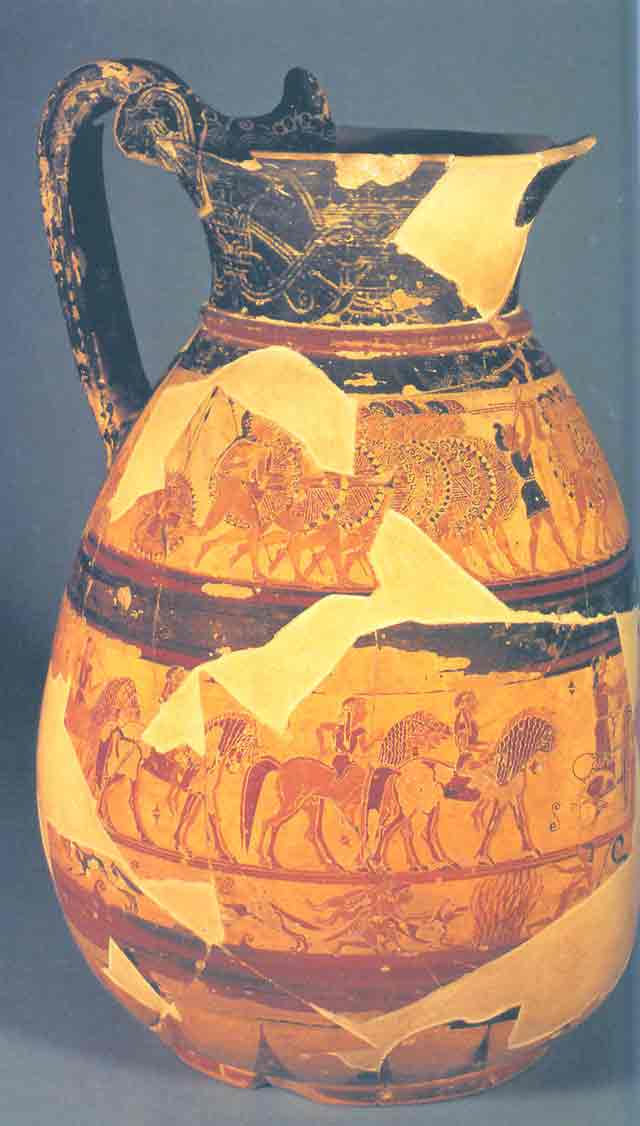 Image: |
Name @ Provenance:
The Chigi Vase (protocorinthian olpe), Corinth
Findspot @ Date: Tuscany, 650 BCE
Material @ Size:
10.25 in
Preservation:
Some parts lost
Present Location:
Villa Giulia
Museum, Rome
Description:
Polychrome painting that has three registers of figures; the lowest shows
humans, hounds and hares. Above, there is a procession of chariot, horsemen,
and a lion hunt, which is separated from the mythological scene of Paris’ judgment with
sphinxes. Main frieze shows lines of heavily armed foot soldiers carrying
shields.
Interpretation:
Gives us important information about military history, shows ascendancy of
drilled foot soldiers over cavalry. Very best of protocorinthian vase painting…
|
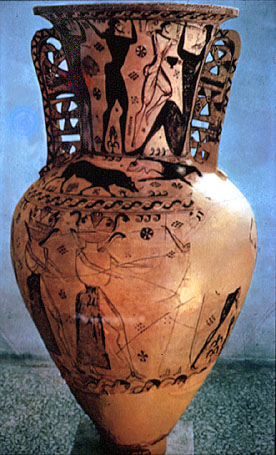 Image: |
Name @ Provenance: The
Eleusis amphora
(protoattic amphora)
Findspot @ Date:
650 BCE
Material @ Size:
4ft. 9in.
Preservation:
Perseus and Athena are fragmentary
Present Location: Archaeological
Museum, Eleusis
Description:
Shows the Gorgons in pursuit of Perseus in the main frieze. The hero has just
decapitated heir sister Medusa and is running off with her head. Gorgons drawn
in outline, added white paint shows facial details. On shoulder, animal combat
with boar and lion, on the neck Odysseus and companions blind Polyphemos.
Incision and white paint used for details, image encompasses a wide time span.
Interpretation:
Increasing interest in mythology, conveys victory of Greek hero over world of
monsters. Shows two approaches to narrative: on the body, the single episode of
Perseus to stand for the entire story, on the neck two different episodes
(Polyphemos with wine cup and with eye poked out)… burial jar for a child.
Suggests pre-existing style for drawing narratives.
|
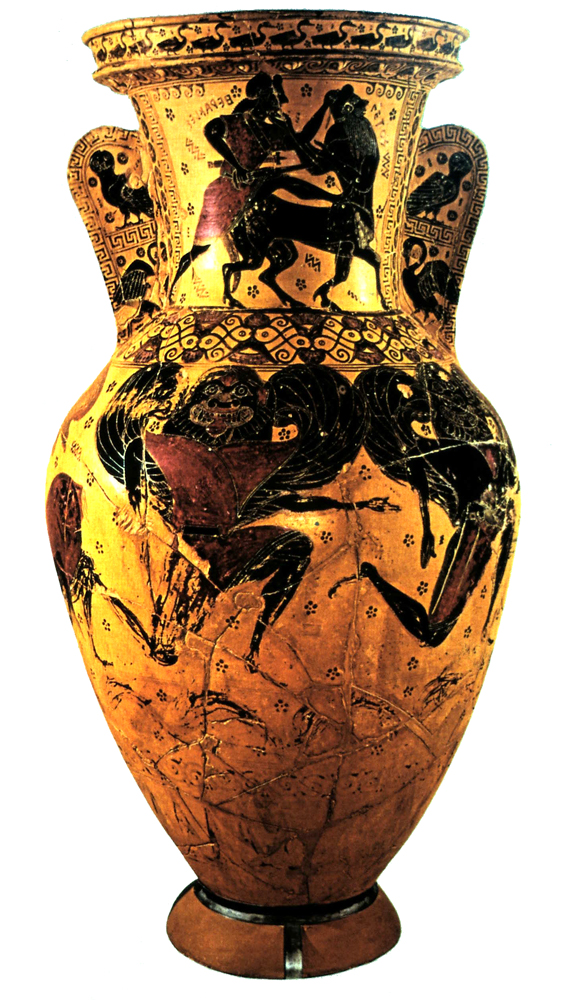 Image: |
Name @ Provenance: The Nessos amphora
(late protoattic/early black figure amphora)
Findspot @ Date: Athens, 625-600BCE
Material @ Size: 4ft
Present Location:
National Museum,
Athens
Description:
Non-functional handles, winged Gorgons, tongues protruding, in kneeling
position (meant to show motion). Perseus not shown, but dolphins below
emphasize chase across the ocean. Geese plod around the rim, birds (Athenian
owl) on handles. On the neck, battle between Herakles and centaur Nessos
(identified by inscriptions). Herakles stabs the centaur for violating his
wife, centaur in position of submission.
Interpretation:
At this time, black figure technique introduced and used for large scale
narrative scenes. Geometric fillers no longer used. Transition between
Protoattic tradition and beginning of Attic black figure.
|
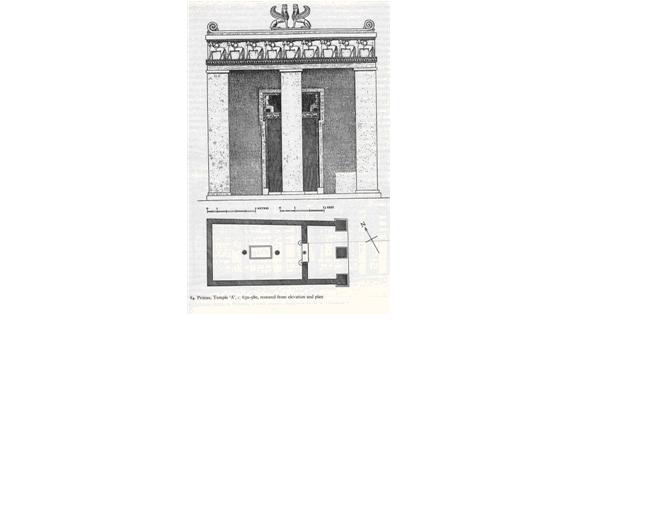 Image |
Name @ Provenance:
Plan of temple, Prinias
Findspot @ Date: Crete, 625-600 BCE
Material @ Size: Stone
Description: Rectangular
cella, porch with three enormous piers, one exactly on the axis of the
building. In the interior of the cella there was a hearth or sacrificial pit
flanked by two columns (like Bronze Age Mycenaean halls).
Interpretation: Recalls Bronze Age practices like those at Phaistos.
|
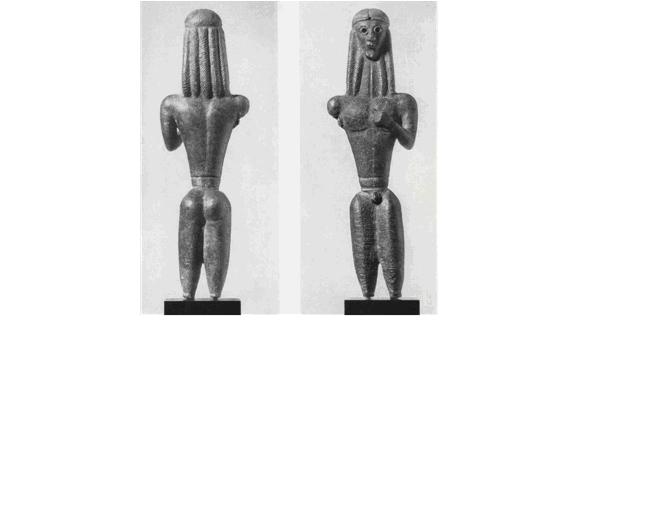 Image |
Name @ Provenance: The
Mantiklos Bronze, from Thebes, Boeotia
Findspot @ Date:
700 -625BCE
Material @ Size:
Bronze, 7.8in
Present Location: Museum of Fine Arts,
Boston
Description: Cylindrical
thighs, triangular torso, pyramidal neck, triangular face, and hemispherical
crown. Less two dimensional, more rounded than predecessors. Two hexameter
verses by Mantiklos inscribed on the thighs: “Mantiklos dedicated me to the
Far-shooter with the Silver Bow from his tithe; grant, Apollo, something good
in return”
Interpretation: Newfound
love of writing, prayer to the god Apollo. Familiarity (me) used to suggest
living or lifelike quality of the bronze.
A continuation of geometric forms to show anatomy from pre-Archaic
period..
|
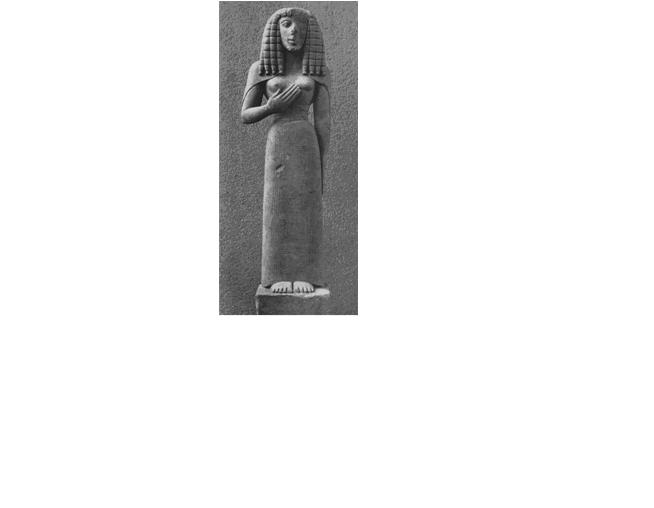 Image |
Name @ Provenance: “Lady
of Auxerre” statuette, from Crete
Findspot @ Date: 640
BCE
Material @ Size:
Limestone, 25.5in
Present Location: Musee
de Louvre, Paris
Description:
enlarged translation of the mold-made terracotta form into stone, Daedalic
style after the sculptor Daedalus. Long dress, elaborately decorated skirt with
incised concentric squares that were originally painted, broad belt pinches in
the high narrow waist, cloak covers shoulders. Her face is triangular, low
brow, vertical strands of hair w/ horizontal waves, large feet come out from
skirt. Holds left hand flat agains leg and right hand across body between
breasts
Interpretation: Gesture
signifies adoration,
|
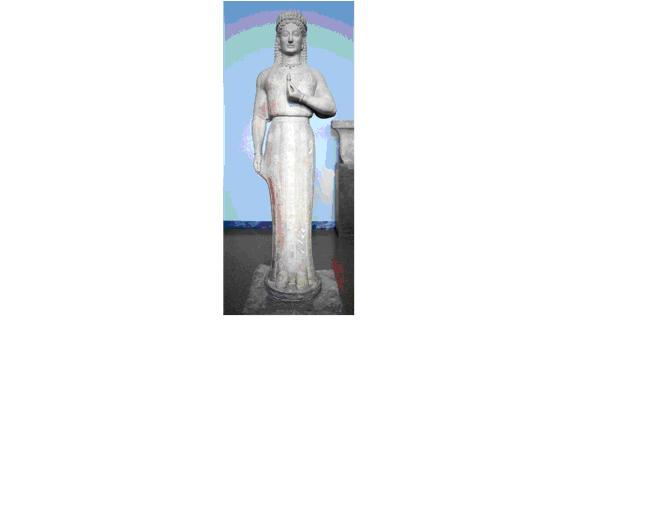 Image |
Name @ Provenance: Phrasikleia,
and her inscribed base, from Merenda, Attica
Findspot @ Date: 540
BCE
Material @ Size:
Marble, 6ft 1in
Present Location:
National Museum,
Athens
Description:
Interpretation:
|
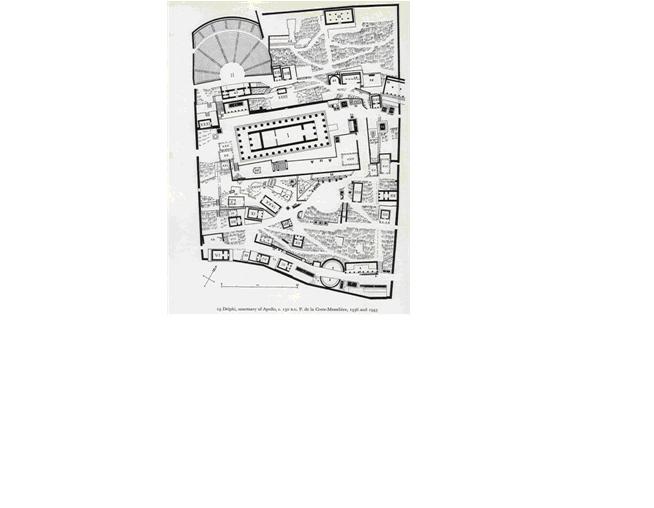 Image |
Name @ Provenance: Plan
of the sanctuary of Apollo, Delphi
|
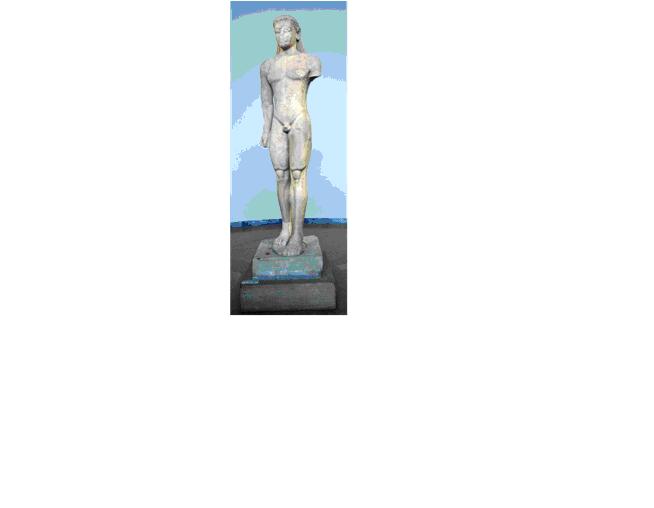 Image |
Name @ Provenance:
Sunion Kouros, from Sunion
Findspot @ Date: Sanctuary
of Poseidon at Cape
Sunion, c. 580BC.
Material @ Size:
Marble, 9ft. 10in
Preservation: Left
arm, left leg, and part of face restored
Present Location:
National Museum,
Athens
Description: Massive
head larger than natural proportions, huge eyes, ears, knees, and ribs fixed in
the surface as a pattern on the marble, defined by line rather than mass.
Interpretation: Kouroi
stood in sanctuaries or cemeteries or occasionally represented divinities.
Votive offerings to god or commemorative markers over grave they spoke to the
social standing of the family. One leg always advanced and fists are clenched
at the sides.
|
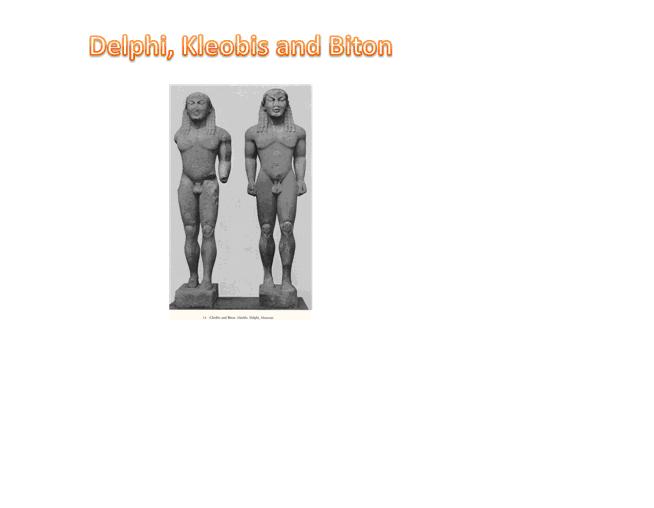 Image: |
Name @ Provenance: Twin
kouroi, from Delphi
Findspot @ Date:
Sanctuary of Apollo at Delphi, c. 530BC.
Material @ Size:
Marble, 6ft. 6in
Present Location:
Delphi Museum
Description: Step
forward together. Traveler’s boots on their feet reference the myth.
Inscriptions on base and thighs, and hairstyles reminiscent of Daedalic style,
short, square torsos and stocky proportions.
Interpretation: Associated
with a regional Argive workshop, by “…medes”. Identified as Kleobis and Biton,
who in one of Herodoto’s tales took the place of the missing oxen who should
have pulled their mother’s cart but some scholars argue that they are Castor
and Pollux.
|
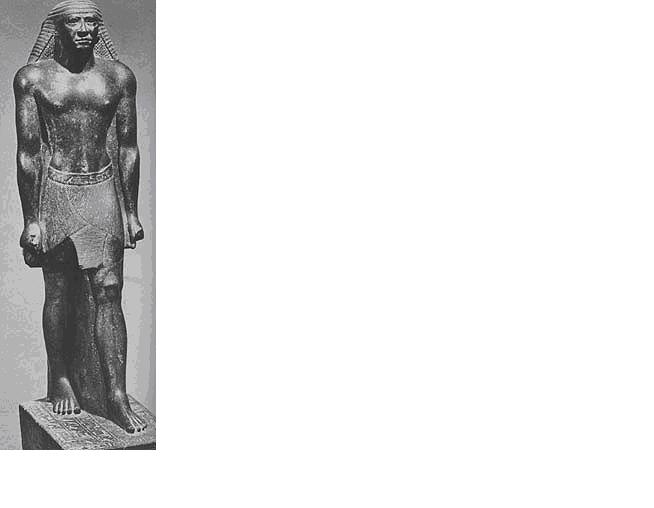 Image: |
Name @ Provenance:
Mentuemhet, Egyptian prince
Findspot @ Date:
Early 6th century
Material @ Size:
Granite, 5ft. 6in.
Present Location: Cairo Museum
Description:
Clothed kouroi influenced Greek sculptors who had started making naked
sculptures.
Interpretation: Kouroi
stood in sanctuaries or cemeteries or occasionally represented divinities.
Votive offerings to god or commemorative markers over grave they spoke to the
social standing of the family. One leg always advanced and fists are clenched
at the sides.
|
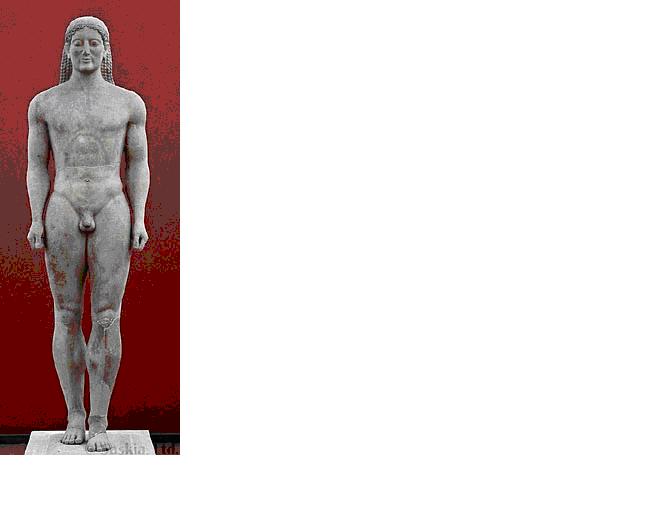 Image: |
Name @ Provenance:
Anavysos Kouros, from Anavysos, Attica
Findspot @ Date:
c. 530BC.
Material @ Size: Marble,
6ft. 4.5in.
Present Location:
National Museum,
Athens
Description:
Advances towards more naturalistic proportions and supple contours. The sculptor
has penetrated the block of a greater depth and has achieved better three dimensionality.
“Archaic smile”. Posture, gesture, bilateral symmetry, patterned anatomy, and
hair have not have not changed.
Interpretation: Kouroi
stood in sanctuaries or cemeteries or occasionally represented divinities.
Votive offerings to god or commemorative markers over grave they spoke to the
social standing of the family. One leg always advanced and fists are clenched
at the sides.
|
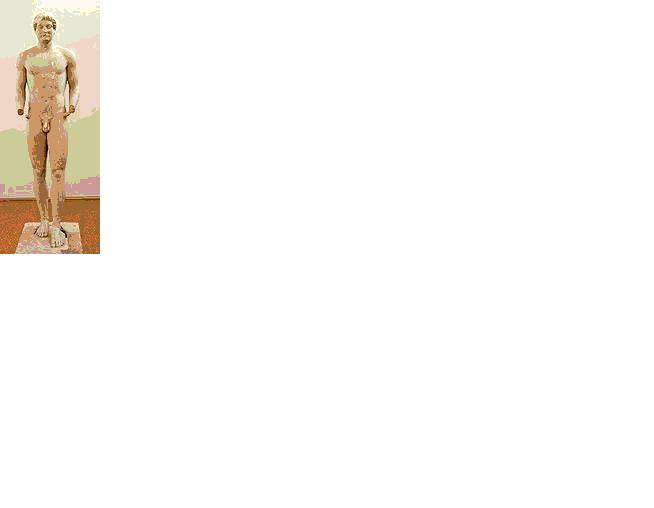 Image: |
Name @ Provenance:
Aristodikos Kouros, from Attica
Findspot @ Date:
c. 500BC
Material @ Size:
Marble, 6ft. 5in.
Present Location: National Museum,
Athens
Description: More
naturalistic, shorter but still patterned hair, arms move away from flanks,
sinew, bone, knee, and shin appear more realistic..
Interpretation: Grave
marker of Aristodikos; trying to find more compelling and worth images to
represent both men and gods leads them away from superhuman scale and abstract
linear form.
|
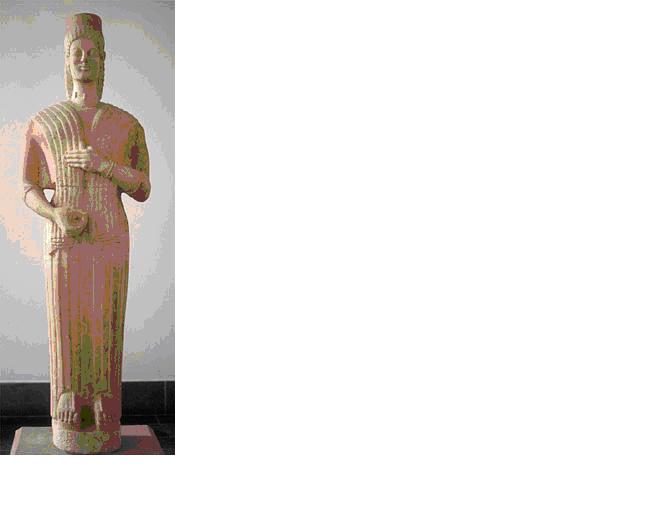 Image |
Name @ Provenance:
Berlin Kore, from Keratea, Attica
Findspot @ Date: c.
570 – 560BC.
Material @ Size:
Marble, 6ft. 3in
Present Location: Staatliche Museen, Berlin
Description:
Frontal stance, large features of her face, big feet and hands, holds a
pomegranate, simple lines of her garments, elaborate jewelry – a bracelet, a
necklace, and earrings. Tasseled mantle slung symmetrically over shoulders, a
chiton, and painted headdress.
Interpretation:
Perhaps this funerary statue is a reward for the dead, for compensation or
exchange. Perhaps it is a symbol of family prestige.
|
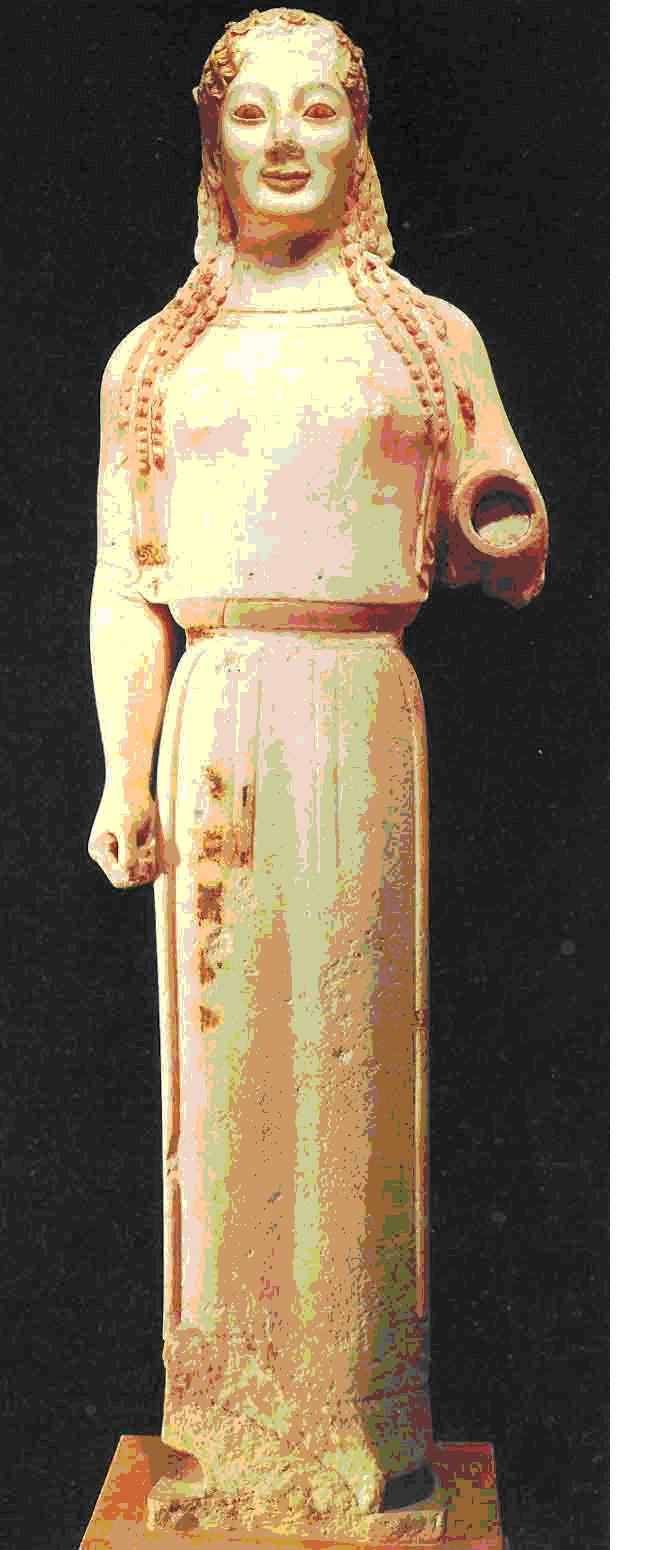 Image |
Name @ Provenance: Peplos
Kore, from Athens
Findspot @ Date:
c. 530BC
Material @ Size:
Marble, 4ft.
Present Location:
Acropolis Museum,
Athens
Description:
Wears a peplos over her chiton, among the last of the kore to wear a peplos.
Smaller than life-size, richly decorated with paint, asymmetrical – head turned
slightly, left arm bent carrying the gift. Right arm has hole for a lost meal
attachment
Interpretation: Perhaps
this funerary statue is a reward for the dead, for compensation or exchange.
Perhaps it is a symbol of family prestige. Note the brightly painted/ metal
accessorized statues were much livelier than they are now.
|



